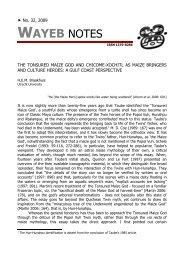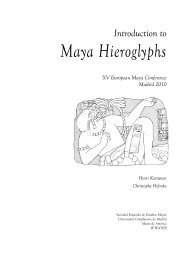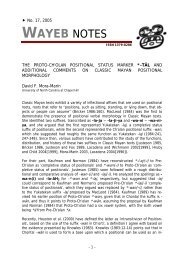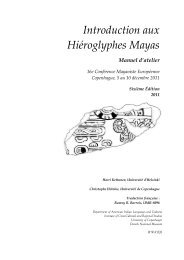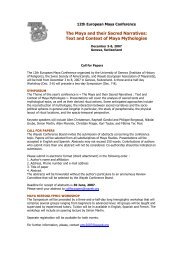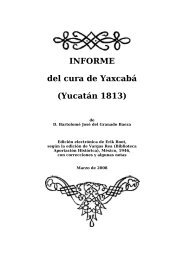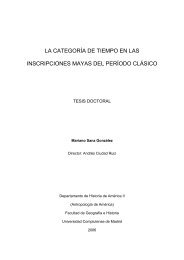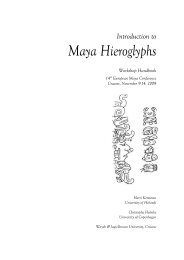Introduction to Maya Hieroglyphs - Wayeb
Introduction to Maya Hieroglyphs - Wayeb
Introduction to Maya Hieroglyphs - Wayeb
Create successful ePaper yourself
Turn your PDF publications into a flip-book with our unique Google optimized e-Paper software.
Kettunen & Helmke 2011<br />
Glossary of Linguistic Terminology<br />
assimilation<br />
A process of fusing one sound <strong>to</strong> another <strong>to</strong> facilitate pronunciation. For example, the /n/ in the Yukatek word<br />
chila’n (interpreter) becomes /m/ before the word balam (jaguar), i.e. the /n/ assimilates in place of articulation <strong>to</strong> the<br />
following s<strong>to</strong>p /b/. The sounds are thus fused <strong>to</strong>gether in pronunciation <strong>to</strong> yield chila’m balam (or: /čila’mbalam/).<br />
bilabial<br />
Bilabial sounds are produced by using both lips. In Classic <strong>Maya</strong> language there are five bilabial sounds: /p/, /p’/,<br />
/b/, /m/, and /w/.<br />
brackets<br />
Brackets 85 […] are used in epigraphic analysis <strong>to</strong> indicate reconstructed sounds and in transliterations <strong>to</strong> designate<br />
infixed syllables or words. In linguistics, square brackets are also generally used for indicating PHONETIC sounds<br />
in contrast <strong>to</strong> PHONEMIC or GRAPHEMIC material (indicated by slashes /…/ and , respectively), i.e.<br />
[t] simply means the phonetic sound ‘t’, and /t/ represents the phoneme ‘t’ (whether it is pronounced as [t] or as [t h ]).<br />
case<br />
Case is a grammatical category characterized by inflection and determined by the syntactic or semantic role of a<br />
noun or pronoun (traditionally the term case has been restricted <strong>to</strong> apply <strong>to</strong> only those languages which indicate<br />
certain functions by the inflection of nouns, pronouns, or noun phrase constituents)<br />
causative verb<br />
Causative verb is a verb with an argument that expresses the cause of the action expressed by the VERB: e.g.<br />
Chris<strong>to</strong>phe had Julie excavate a burial. In a certain class of verbs there is alternation between a causative reading<br />
and an INCHOATIVE reading: e.g.<br />
inchoative:<br />
causative:<br />
The vase broke<br />
Joe broke the vase<br />
clause<br />
A verbal phrase formed <strong>to</strong>gether with a nominal or adverbial phrase. Clauses can either be independent or<br />
dependent: e.g., in the sentence “I know that you will enjoy deciphering <strong>Maya</strong> glyphs” the independent clause is<br />
“I know (that you will enjoy deciphering <strong>Maya</strong> glyphs)”, which contains the dependent phrase or clause “that<br />
you will enjoy deciphering <strong>Maya</strong> glyphs”.<br />
clitic<br />
A clitic is a grammatical element which has syntactic and semantic characteristics of a word but cannot occur<br />
freely (in SYNTAX) and, therefore, needs a “host” (i.e. a clitic is a bound MORPHEME). Clitics can also attach <strong>to</strong><br />
inflected words, a fact that distinguishes them from AFFIXES. Clitics are divided in<strong>to</strong> two classes: proclitics and<br />
enclitics; proclitics attach themselves before the host word, and enclitics attach themselves after the host. In <strong>Maya</strong><br />
hieroglyphic writing there are a number of clitics. One of the most common is the temporal DEICTIC (en)clitic –jiiy<br />
(“ago”).<br />
cocktail party effect<br />
Binaural hearing (using both ears) helps us <strong>to</strong> separate interesting sounds from a background of irrelevant noise.<br />
In a <strong>Maya</strong> hieroglyphic workshop where several conversations are taking place, one can focus on ergative<br />
patterns or temporal deictic enclitics and ignore discussions relating <strong>to</strong> leisure activities.<br />
85<br />
This is brackets in standard American English and square brackets in British English.<br />
132/154



